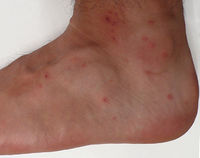Difference between revisions of "Trombiculidiasis"
| Line 41: | Line 41: | ||
{{Learning | {{Learning | ||
|literature search = [http://www.cabdirect.org/search.html?q=title:(%22Trombicula+autumnalis%22)+ ''Trombicula autumnalis'' publications] | |literature search = [http://www.cabdirect.org/search.html?q=title:(%22Trombicula+autumnalis%22)+ ''Trombicula autumnalis'' publications] | ||
| + | |Vetstream = [https://www.vetstream.com/canis/search?s=mite Mites] | ||
}} | }} | ||
Revision as of 17:19, 4 June 2016
| Trombicula autumnalis | |
|---|---|
| Phylum | Arthropoda |
| Class | Arachnida |
| Order | Trombidiformes |
| Family | Trombiculidae |
| Genus | Trombicula |
| Species | T.autumnalis |
Caused by: Trombicula autumnalis also known as: Harvest mite — Neotrombicula autumnalis — Chiggers
Introduction
Trombicula autumnalis are surface mites found worldwide. It will attack and parasitise any animal including humans, causing parasitic skin infestation (trombiculidiasis). Only the larval stage is parasitic however, and adult mites are found living in the soil.
Identification
The mites are bright orange in colour and hairy. They have six legs and no spiracles. They breathe through their cuticle.
Lifecycle
The lifecycle of Trombicula autumnalis mites lasts around 50 to 70 days. The nymphal and adult stages are free-living in the soil. Eggs are laid in soil and once hatched, larvae climb up vegetation in search of a host to attach to. As the name suggests, numbers are greatest in 'harvest' time, late summer, in temperate climates and all year round in the tropics.
Pathogenesis
The larvae insert their mouthparts into the host's skin and inject cytolytic enzymes. They then feed on partly digested host tissue causing irritation and potentially a hypersensitivity reaction. The Mites are mainly found on the head, ears and flanks of pets and can be found on the face and limbs of grazing animals, depending upon the host height.
Clinical Signs
The animal will show signs of intense pruritus and orange to red coloured larvae may be visible on the skin. There will be a erythematous, papular rash and also crusting and scaling.
Diagnosis
Clinical signs and the time of year is indicative of the parasite. On physical examination, it is likely the parasite will be seen. Skin scraping, coat brushing or a tape strip may reveal the presence of the mite. Microscopically, the skin will appear hyperplastic with superficial perivascular dermatitis and the presence of eosinophils and mast cells.
Treatment and Control
Treat infected animals with a licensed acaracide. Control is almost impossible, if animal has a known hypersensitivty reaction then try to avoid affected areas ('hot-spot') during the season.
| Trombiculidiasis Learning Resources | |
|---|---|
To reach the Vetstream content, please select |
Canis, Felis, Lapis or Equis |
 Search for recent publications via CAB Abstract (CABI log in required) |
Trombicula autumnalis publications |
References
Brown, C.M, Bertone, J.J. (2002) The 5-Minute Veterinary Consult- Equine, Lippincott, Williams & Wilkins
Blood, D.C. and Studdert, V. P. (1999) Saunders Comprehensive Veterinary Dictionary (2nd Edition) Elsevier Science
Foster, A, and Foll, C. (2003) BSAVA small animal dermatology (second edition) British Small Animal Veterinary Association
Fox, M and Jacobs, D. (2007) Parasitology Study Guide Part 1: Ectoparasites Royal Veterinary College
| This article has been peer reviewed but is awaiting expert review. If you would like to help with this, please see more information about expert reviewing. |
Error in widget FBRecommend: unable to write file /var/www/wikivet.net/extensions/Widgets/compiled_templates/wrt69553b0d0680e8_92288467 Error in widget google+: unable to write file /var/www/wikivet.net/extensions/Widgets/compiled_templates/wrt69553b0d12ddf5_66947958 Error in widget TwitterTweet: unable to write file /var/www/wikivet.net/extensions/Widgets/compiled_templates/wrt69553b0d19d8d9_02749362
|
| WikiVet® Introduction - Help WikiVet - Report a Problem |
